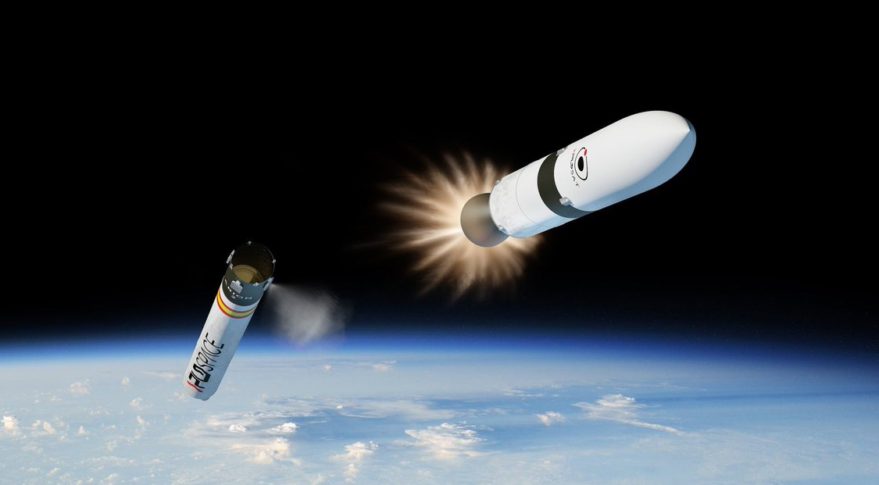Blog Credit: Trupti Thakur
Image Courtesy: Google
Miura-1
Spanish aerospace company PLD Space has achieved a significant milestone by successfully launching its recoverable Miura-1 rocket. This achievement marks Europe’s first fully private rocket launch and offers a glimmer of hope for Europe’s space ambitions. The Miura-1 rocket, named after a fighting bull, conducted a suborbital test flight with the goal of gathering crucial data for future missions.
The Miura-1 Rocket
The Miura-1 is a single-stage rocket standing at an impressive 41 feet (12.5 meters) tall. It has a payload capacity of approximately 220 pounds (100 kilograms) for suborbital space flights. The rocket is designed with the capability for recovery, making it a pioneering project in Europe.
Mission Objectives
The primary objective of the Miura-1 rocket’s debut mission was to conduct a suborbital test flight. During this flight, an experiment from the German Center of Applied Space Technology and Microgravity was carried out to study microgravity conditions. Additionally, PLD Space placed photos of its employees on board to commemorate this milestone moment. The mission culminated with the rocket’s splashdown into the Atlantic Ocean.
The Path to Miura-5
PLD Space has ambitious plans for the future. The Miura-5, an orbital rocket featuring a reusable first stage, is scheduled to launch as early as 2025 and enter service in 2026. This larger rocket will operate from Europe’s Spaceport in Kourou, French Guiana.
Challenges and Scrubbed Attempts
The path to success for the Miura-1 rocket was not without challenges. An initial launch attempt in June was aborted just 0.2 seconds before liftoff due to a cable issue. Subsequent investigations revealed that the cable had indeed been released but with a slight delay. Persistence paid off, leading to the successful launch in October.
Europe’s Evolving Space Ambitions
The successful launch of the Miura-1 rocket underscores Europe’s determination to bolster its capabilities in space exploration. Recent disruptions to European space launches, including delays in the Ariane 6 program and technical issues with the Vega-C rocket, have highlighted the importance of private ventures like PLD Space in filling the gap. Europe is actively seeking to regain autonomous access to space, and the Miura-1 launch represents a significant step in that direction.
Miura 1 (previously called Arion 1) is a suborbital recoverable launch vehicle developed by the Spanish company PLD Space. It is planned to be the first recoverable launch vehicle in Europe.
Design
Miura 1 was originally proposed as a two-stage rocket capable of achieving suborbital flight. It was originally planned to be 12 m long, with a capacity of 250 kg (551 lb). The engines were to use liquid oxygen and kerosene as propellants.
In its final design, Miura 1 is a 12.7 m long 0.7 m diameter one-stage rocket, propelled by one TEPREL-B engine. The vehicle can fly a payload of up to 200 kg on a suborbital trajectory. The propulsion system is equipped with actuators to tilt the engine for an active thrust vector control. In its first mission, it will carry 100 kg of payload to an apogee of 153 km. Additionally, Miura 1 is equipped with a recovery system using its engines and parachutes that enable PLD Space to recover the vehicle from the ocean and re-use the complete launch vehicle. With this, it will be the first recoverable launch vehicle in Europe. Miura 1 is intended to be used for scientific research or technology development in a microgravity environment and/or in the upper atmosphere. Furthermore, about 70% of the technology developed for Miura 1 is planned to be used on the Miura 5 orbital rocket.
Development progress
In December 2019 GMV announced that the Miura 1 avionics system had passed the qualification phase.
In March 2020, the stress test of the Miura 1 pressurized tanks was carried out to check their ability to withstand the working pressure (more than 400 bars (5,800 psi)) with a successful result. COPVs (Composite Overwrapped Pressure Vessel) are used to pressurize propellant tanks and are a fundamental element of many launchers.
In July 2020 the German Center of Applied Space Technology and Microgravity (ZARM) successfully completed vibration tests of its payload that will fly on the first launch (Test Flight-1) of Miura 1.
On April 7, 2022, the company carried out the first test of the complete launcher at its facilities in Teruel, being the first test in Europe of a rocket aimed to reach space propelled by liquid fuel.
First launch
The first test flight of Miura 1 was initially planned for 2021 from an experimental rocket launch site in Huelva, southwestern Spain, called El Arenosillo, and it will carry a payload from the German Center of Applied Space Technology and Microgravity (ZARM). Up to eight suborbital launches are targeted per year. It has been delayed to 2022.
On May 31, 2023, Miura 1, a launch window opened at 00:00 UTC, but was cancelled due to upper-level winds. On June 17, the company tried again, but the ignition of the engines was canceled due to the onboard systems detecting abnormal parameters in the vehicle. Following that, and taking into account the increased risk of fires around the launch area due to high temperatures, the company decided in coordination with the Civil Guard to postpone a new launch attempt until fall. The launch occured on October 7, 2023, at 00:19 UTC. The rocket reached an apogee of 46 km. The landing outcome is not known.
Blog By: Trupti Thakur

10
OctMiura-1
Oct 10, 2023Recent Blog
The V2G TechnologyApr 21, 2025
Country’s Specific Domain By GoogleApr 19, 2025
The ITES-QApr 17, 2025
The UPI Circle Of PhonePeApr 16, 2025
Dangerous AI In HealthcareApr 15, 2025




